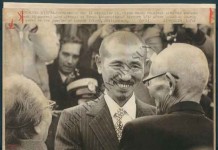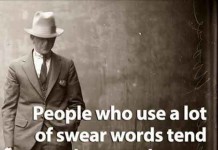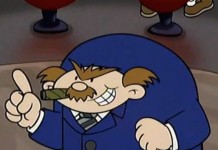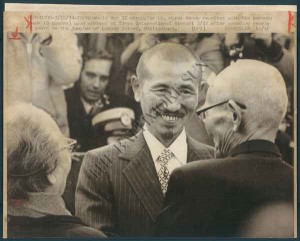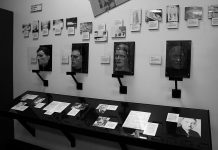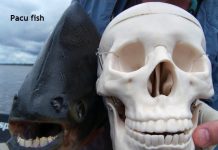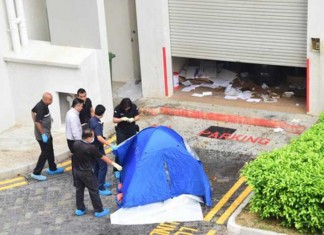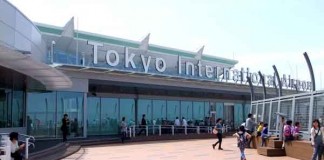A Japanese soldier who continued fighting World War II a full 29 years after the Japanese surrendered, because he didn’t know the war was over.
Hiroo Onoda is a Japanese citizen that originally worked at a Chinese trading company. When he was 20 years old, he was called to join the Japanese army. He promptly quit his job and headed off to training in Japan. At a certain point in his training, he was chosen to be trained at Nakano School as an Imperial Army Intelligence Officer. In this specialized military intelligence training, he was specifically taught methods of gathering intelligence and how to conduct guerrilla warfare. He was being groomed to go in behind enemy lines and be left with small pockets of soldiers to make life miserable for Japan’s enemies and gather intelligence in the process.
On December 26th, 1944, Onoda was sent to Lubang Island in the Philippines. His orders from his commanding officers, Major Yoshimi Taniguchi, were simple: You are absolutely forbidden to die by your own hand. It may take three years, it may take five, but whatever happens, we’ll come back for you. Until then, so long as you have one soldier, you are to continue to lead him. You may have to live on coconuts. If that’s the case, live on coconuts! Under no circumstances are you [to] give up your life voluntarily.
Onoda then linked up with Japanese soldiers already on the island and shortly thereafter the island was overrun by enemy troops when other officers that were already on the island refused to help fulfill part of the orders that Onoda was given to destroy the harbor and airfield among other things. This in turn made it easier for the Allied forces to conquer the island, landing on February 28th, 1945. Shortly after the island was conquered the remaining Japanese soldiers split up into small groups of 3 or 4 and headed into the jungle.
Most of these small groups were quickly killed off. Onoda’s group though consisting of himself, Yuichi Akatsu, Siochi Shimada, and Kinshichi Kozuka, were not. They continued to use guerrilla warfare tactics to harry the enemy troops as best they could while strictly rationing supplies including food, ammo, etc. Supplementing their small rice rations with bananas, coconuts, and other food from the jungle as well as doing raids on local farms when they could manage it.
In October 1945, after another cell had killed a cow from a local farm for food, they came across a leaflet from the local islanders to them saying “The war ended August 15th. Come down from the mountains!” The few remaining cells discussed this leaflet extensively, but eventually decided that it was Allied propaganda trying to get them to give themselves up. They felt that there was no way that Japan could have lost so quickly since the time when they were deployed. Indeed, this would seem strange to anyone who had no knowledge of the atomic bombs dropped on Hiroshima and Nagasaki. Also, another one of the cells had been fired upon just a few days before; they felt that this wouldn’t have happened if the war was over.
Eventually, near the end of the same year local islanders, fed up with being shot at and raided, got a Boeing B-17 to drop leaflets all over the jungle. These leaflets had the order to surrender printed on them from General Yamashita. The few remaining cells once again scrutinized these leaflets to try to determine their authenticity. In the end, the wording on the leaflet pertaining to the method with which they would be sent back to Japan seemed fishy to them; largely because the wording made it seem as if Japan had lost, something they couldn’t fathom and which was a big problem in their willingness to accept the war had ended. If Japan had won, they would come and get them. Japan couldn’t lose, so the war must still be going. So they once again believed it was the Allies becoming more tired of their successful guerrilla tactics and trying to get them to surrender.
When this didn’t work, more leaflets were dropped with newspapers from Japan; photographs and letters from the soldiers families; delegates were sent from Japan and went through the jungle speaking over loudspeakers begging the soldiers to give themselves up. In every case the cells encountered, there was always something suspicious in their minds about the way it was done to cause them to believe it was an elaborate hoax by the Allied troops.
Years passed in the jungle with these four soldiers continuing to perform their sworn duty of harrying the enemy at every opportunity and gather intelligence as best they could. At a certain point, when most everybody they saw was dressed in civilian clothing, they began thinking that this too was a ruse from the Allied forces to lull the Japanese guerrilla soldiers into a false sense of confidence. They considered the fact that every time they fired on these “civilians” shortly thereafter search parties would arrive hunting them. Over time they had gradually let their solitude twist their minds into thinking everyone was an enemy, even their own fellow Japanese who would occasionally come and try to find them and get them to come home. These of course in their minds were Japanese prisoners forced to come lure them away from the safety of the jungle.
Eventually, after about 5 years in the jungle, Akatsu decided he would surrender, but didn’t tell the other three soldiers. So, in 1949 he slipped away from the others and after 6 months alone in the jungle was able to successfully surrender to what he thought were Allied troops. Because of this event, Onoda’s cell became even more cautious and went into deeper hiding and took fewer risks as they viewed Akatsu leaving as a security threat. “What if he was captured”, they thought.
About 5 years later, another of the small group, Shimada was killed in a skirmish on the beach at Gontin. Now there were only two, Onoda and Kozuka. For about 17 more years the two lived in the jungle, gathering intelligence as best they could and attacking the “enemy troops” when they could risk it. They were still convinced that eventually Japan would dispatch more troops and they would then train these troops in guerrilla warfare and use the intelligence they had gathered to re-take the island. After all, their orders were to stay put and do as they had done until their commanding officer came and got them and their commanding officers had promised to do so no matter what.
Now in October 1972, after 27 years of hiding Kozuka was killed during a fight with a Filipino patrol. The Japanese had long thought he had already died, they didn’t think he could have survived so long in the jungle. But now when they had his body, they began thinking perhaps Onoda was also still alive, even though he had also long since been declared dead.
The Japanese then sent a search party to try to find Onoda in the jungle. Unfortunately, he was too good at hiding with 27 years of practice. They could not find him. Onoda continued his mission.
Finally in 1974 a college student, Nario Suzuki, decided to travel the world. Among his list of things to do on his journey was to find “Onoda, a panda, and the Abominable Snowman”. He traveled to the island and trekked through the jungle searching for signs of Onoda. Shockingly, where literally thousands of others through the last 29 years had failed, Suzuki succeeded. He found Onoda’s dwelling place and Onoda himself.
He then proceeded to try to convince Onoda to come home with him. Onoda refused. His commanding officers had said they would return for him no matter what. He would not surrender nor believe the war was over until they returned and ordered him to do so. At this point, he would not have been allowed to simply go home; he would be required to surrender and throw himself on the mercy of the enemy. Over the years he had been too successful at using the guerrilla tactics he had mastered. Killing 30 Filipinos and injuring over 100 others as well as destroying various crops and the like for almost 30 years.
Suzuki then traveled back to Japan with the news he’d found Onoda; Major Taniguchi, now retired and working at a book store, was then brought back to the island and to Onoda to tell him that Japan had lost the war and he was to give up his weapons and surrender to the Filipinos.
As you might expect, after living in the jungle doing what he thought was his duty helping Japan, now only turning out to be wasting 29 years of his life, and worse killing and injuring innocent civilians, this came as a crushing blow to Onoda.
Suddenly everything went black. A storm raged inside me. I felt like a fool for having been so tense and cautious on the way here. Worse than that, what had I been doing for all these years?
Gradually the storm subsided, and for the first time I really understood: my thirty years as a guerrilla fighter for the Japanese army were abruptly finished. This was the end.
I pulled back the bolt on my rifle and unloaded the bullets. . . .
I eased off the pack that I always carried with me and laid the gun on top of it. Would I really have no more use for this rifle that I had polished and cared for like a baby all these years? Or Kozuka’s rifle, which I had hidden in a crevice in the rocks? Had the war really ended thirty years ago? If it had, what had Shimada and Kozuka died for? If what was happening was true, wouldn’t it have been better if I had died with them?
On March 10th, 1975 at the age of 52, Onoda in full uniform that was somehow still immaculately kept, marched out of the jungle and surrendered his samurai sword to the Philippine President Ferdinand Marcos. Marcos, very unpopularly in the Philippines, but immensely popular in Japan, pardoned Onoda for his crimes, given that Onoda had thought he was still at war the entire time.
Now in the end, we might look at Onoda as a fool and worse, a murder of innocent people. In the end, he was both of those things, there is no denying it. But at the same time, not everyone who lives by strict convictions and puts their all into achieving what they believe to be the right thing, ends up having what they strive towards turn out well or end up being a good thing. This is one of those cases where someone did something remarkable, showing extreme dedication to his country and his duty, as well as fortitude unmatched by many in history.
Had circumstances been different and the war really had waged on so long; soldiers and people from both sides of the fight would have respected him for his courage and dedication. In that respect he was more of a hero. However, the world wasn’t the way he thought and in the end, in retrospect, he was more a fool than anything else. But at the same time, we can’t ignore that this was a man who did something great with respect to doing something that few others could have done; had circumstances been as he thought, what he did was something to be admired. He faced (what he thought) was death around every corner and lived in an extreme situation for 30 years, fighting for his country. That should be respected. It’s a rare person who could do something like that and never quite or surrender; never take the easy way out as most of us do all the time when faced with adversity that is orders of magnitude less than what Onoda faced for almost 30 years in the jungle.




